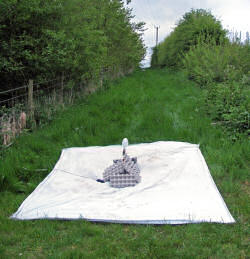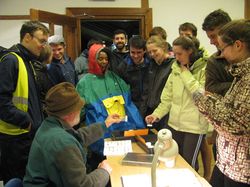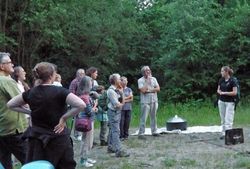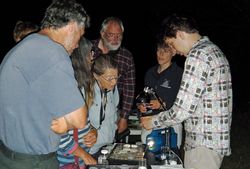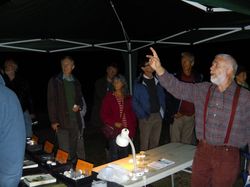Click the event location to view the species recorded
| March 2013 -
Lake Vyrnwy - SH965241 |
||||
| 20/04/13
- Pont
Llogel - SJ032154
After
the disappointment of having to cancel our first
event of the season due to heavy snow, it was good to be able to get
our traps
out for the Pont Llogel event. Peter. |
||||
18/05/13
- Tyddyn Dauddwr - SJ235173
Our second event of the year was kindly hosted by Rod Aspinwall at his organic smallholding in the north-east of the county. The site is a mix of habitats with mature woodland, hedgerow, meadow and several large ponds. With six MV lights we were able to cover these different habitats well. Relative to the rather poor weather we have had so far this year, the night itself was dry and mild.Dave
Green attended this event equipped with a beating tray and his sharp
pair of eyes. Throughout the night, Dave was actively looking for early
stages and recorded several caterpillars as well as several leaf mines
and other tell-tale signs. As
the lights were turned on, I netted the first macro species of the
night: Brimstone
and Early Thorn.
It was not long before moths were turning up at the traps: one of the
first was a rather smart Waved
Umber.
While this species is not particularly uncommon it is usually only seen
in low numbers, so we were rather surprised when it proved to be the
commonest moth of the night, with many individuals turning up in most
of the traps. A little while later a small prominent was seen buzzing
around one of the bulbs, and after a little scuffle the moth was potted
and turned out to be a lovely Chocolate-tip.
This species is very localised in the county, being confined to the
north-east corner. Yellow-barred
Brindle and Lesser
Swallow Prominent were the two final macro species of the
night. Micros
were fairly thin on the ground (or should that be ‘in the air’?), with
the notable species being a Monopis
laevigella, the larvae of which feed on decaying animals,
scats and other detritus! A male Nematopogon
swammerdamella was also seen - best known for its
ridiculously extensive antennae. It
wasn’t just moths that kept us busy throughout the night: the site has
an extremely healthy population of Great Crested Newts – a quick peek
in the ponds yielded lots of the impressive amphibians. We even spotted
a female egg laying! The
event was well attended- thanks must go out to Sue for bringing some
scrumptious chocolate cake! When we packed up just before 1am, the
temperature had fallen to 7°C. We had caught 18 species, with an
additional 14 species found in their early stages around the site. A
big thanks to our host for the night, Rod, for holding the event and
keeping us supplied with hot drinks! We may well return to this
beautiful site… |
||||
15/06/13
- CAT - SH755403
This event was run in conjunction with the CAT staff, headed by Adam Thorogood. Before the mothing got under way Adam took everyone on a bat walk with bat detectors. We heard a whole roost of the tiny Pipistrelle bats while they were emerging from their day time roost and Daubenton’s bat was also heard flying low, feeding over the ponds. Several other species of bat are known to be at the CAT site, but on this occasion we only recorded the two, perhaps the weather conditions were slightly against us on the night. Now for the mothing. On this event we were using four different types of light traps which included a portable Heath trap which Douglas brought along for the first time, so we were definitely giving ourselves the best chance to draw plenty of moths in. As the light faded, the traps were switched on, but we got off to a very slow start and it was some while before the first moth, a Pebble Hook-tip, was brought to the table. Slowly things picked up and about an hour later, species were coming in at a steady rate. Marbled White-spot a locally common species, the Pale Tussock, a fairly large rather endearing species and a fresh Green Carpet with superb colours all made an appearance. During the evening several, not so common species were also potted, these included the Satin Lutestring, Clouded Silver and Dwarf Pug. The locally common Devon Carpet (a nationally scarce B species) was probably one of the best species of the night. A Peach Blossom made a very welcome appearance; this beautiful, ‘eye opening’ species always manages to turn a few heads. As the evening drew to a close, the fabulous Elephant Hawk-moth turned up and was shortly followed by the equally stunning, very large Lobster Moth. As we were packing the kit away, the traps yielded the last two species of the evening; these were the usually very common White Ermine and Heart & Dart, but only one of each species on this occasion. Micro moths were once again thin on the ground (and in the air), and only three species were recorded, Syndemis musculana musculana, Epiblema cynosbatella and the slightly less common Nematopogon schwarziellus. The weather undoubtedly continued to play a large part in the low numbers of micro moths recorded. It has been a familiar pattern at all our events this year. This event was well attended as usual and the thirty people who turned up were all given hot drinks and cake which was very welcome indeed. I would like to thank Adam and the CAT staff who volunteered to help run this event, which, despite the weather, was a great success. Peter. |
||||
13/07/13
- Dolforwyn Woods - SO158956
The day of the event was a contender for the hottest day of the year. With cloudless skies, the temperature began to fall after dark but with daytime temperatures nearing 30c, it stayed in the high to mid-teens for most of the night; it was clearly going to be a very busy night. The first macro of the night was a real stunner: a pristine Scallop Shell – a restricted species in the county, which turned out to be locally common. It wasn’t long before moths were coming in thick and
Barred Yellow and Lobster Moth were real crowd-pleasers, with their vibrant colours and hairy hind wings respectively. The next rarity was a Brussels Lace which was shortly followed by a Freyer’s Pug. Clay Triple-lines and Beautiful Hook-tip were two other local species recorded. As we were packing up, a glut of new species were added, including a pristine Large Emerald. Micro species were also present in good numbers, with a stunning Alabonia geoffrella stealing the show. Other notable records included Hedya ochroleucana, Hedya salicella, Tinea pellionella, Epinotia abbreviana and Ephestia parasitella. The event was not the same as usual because Peter Williams was unable to attend due to problems with his back. I am sure everyone will join me in wishing Peter a swift recovery in plenty of time for our next event at Llanymynech Rocks. In total, we recorded 107 species, adding many new site records. The event was well attended and hopefully those who were new to mothing went away feeling enthused! Douglas B. |
||||
10/08/13
- Llanymynech Rocks - SJ267218
We got on site at 8:00pm, where we met up with Rhona and Phil, who were representing Shropshire Wildlife Trust in this joint event with the MMG. The weather was still settled and fairly mild, so we were all chomping at the bit to get started and we were all hopeful of recording our target species for this event, the very elusive Mouse Moth as we dearly wanted a photo for our web site. Base camp was set up on a flat patch of ground where we had previously been and then all the traps were set out along a fairly linear area, no sooner had we done this the lights were switched on and there was just time for a quick bite to eat and a cuppa before the members of the public met in the car park and Rhona walked them up to base camp. As usual, I gave a small introductory talk to the very enthusiastic crowd of 23 people and even while I was doing this, Douglas and Peter were bringing moths to the table – it was going to be a very busy night. Interestingly, the first moths to be potted were three micro moths, all members of the grass moth species; Agriphila straminella, A. tristella, A. inquinatella; later, these were added to by A. geniculea, Catoptria pinella and C. falsella. The first Macro moth was the Small fan-footed Wave, shortly followed by the very common Large Yellow Underwing. Next up was the Annulet, a species which seems to do very well at this site as we found it to be fairly common. The evening was in full swing and many pots filled with moths were coming in at a very fast rate. I could hardly keep up with identifying them, but thankfully Douglas stepped in and gave a hand at the table with the id work. To name but a few; Orange Swift, Yellow Shell, Shaded broad-bar, Pebble Hook-tip, Sallow Kitten, and the beautifully iridescent Gold Spot were all showing their beauty when Rhona brought the star of the show to the table, the fabulous Magpie Moth. Everyone agreed that it was up there with the best of our butterflies. As the evening continued, still more lovely species were trapped; three Thorn species, Dusky, Early and Purple opened a few eyes and these were accompanied by Copper Underwing, Lychnis, Yellow-barred Brindle and the Swallow Prominent. As the evening came to a close there was the usual last flurry of species to be added to the list, including the Engrailed, Dark Marbled Carpet, and the very late Heart & Dart and Triple-spotted Clay. In all, the event yielded an excellent total of 73 species of macro moth. As for other micro moths, the total was just as impressive with 44 species recorded, the most notable ones were; Cochylis hybridella, Pyrausta despicata, Ypsolopha scabrella, Pyrausta cingulata (5th county record) and the plume moth Hellinsia osteodactylus. Notable species for this site were; Pretty Chalk Carpet, Small Waved Umber and Haworth’s Pug which are all limestone loving species. Only three migrant species were recorded; Silver Y, Dark Sword-grass and the small micro moth Udea ferrugalis. The best species of the night was a Dart which none of us could identify at the time, but later under closer examination it proved to be a White-line dart which was only the forth record of this species in the county. As for our target species, the Mouse Moth, try as we may, once again we failed to record this species, so still no photo for us; who knows, perhaps we should have put more cheese in our traps! Anyway, we all went away with the same sentiment ‘we will return’. However, this story does have a rather interesting footnote. The following day, when I opened up my-mails I had one from Douglas, titled ‘You won’t believe it’ and attached was a photo of a Mouse Moth which he had caught that night in his home moth trap. Don’t you just love stories with happy endings! Many thanks to Rhona and Phil from SWT and Douglas and Peter who worked tirelessly throughout the event collecting and identifying species and finally for all the members of the public who I’m sure had a wonderful evening. Peter. |
||||
| 07/09/13
- Hafren Forest - SN857869 For
what had seemed like weeks the weather had been very warm, and the
night time temperatures had held up well, but on the Thursday before
the event, a cold front came across the country and that put paid to us
getting a good species list on the Saturday as the cooler conditions
swept over us.
I’d had a shoulder operation a couple of weeks before and was still unable to drive, so I was very grateful that Alan Tadman kindly collected me and the kit. When we arrived on site the weather conditions were still very good, but you could certainly feel a chill in the air, and for the first time this year, we knew that autumn was with us. All the traps and base camp were set up before dusk which gave us all time to sit around the table to ‘chat moths’ for a while - there’s always something to talk about! On this occasion I had taken a dead pug species along with me which I had found on the ground by my home trap. It was rather squashed; nevertheless, Douglas wanted to take it home to try a genitalia determination. Fortunately, he was successful and found it was a female Toadflax Pug, which is a new species for my home site. Back to the event – as dusk approached the ‘lights’ were switched on and it wasn’t too long before Douglas was in action with his net, bringing both a Small Wainscot and a Dark Marbled Carpet to the table. On our first visit to the traps, Garden Carpet, Small Phoenix, Common Marbled Carpet and the rather smart Autumnal Rustic were added to the list. Rosy Rustic, Spruce Carpet, Early Thorn and Lesser Yellow Underwing were all soon to follow. As the evening drew on the chill in the air got colder and activity around the traps began to diminish, however, we still managed to record Angle Shades, Purple Bar, Flame Carpet and a cracking Pink-barred Sallow. As midnight approached we decided to call it a night, and as the traps were being put away, the rather uncommon Pine Carpet was potted. Micro Moths were pretty thin on the ground; the first one recorded was a dead Agriphila tristella which was found inside the nearby toilet block. Other species to come to light were Eudonia mercurella, Acleris emargana and Acleris laterana. The only other micro record was the leafmine of Mompha raschkiella, which was found on willowherb. The best record of the night was also the only migrant species, a pristine Dark Sword-grass. This is only the second time we have held an event at this site and on this occasion we were certainly unlucky with the weather, but the Hafren Forest has much potential, so, we will definitely come here again, hopefully bringing warmer conditions with us next time! Peter. |
||||
| 05/10/13
- Cors Dyfi - SN704984 The
event started, after several days of rain and wind, on a calm and
warmer evening with temperatures around 14 degrees before cooling later
in the night when the cloud cleared. 7 traps were set up altogether
with 4 along the 300m of available boardwalk, 2 near the hide including
an Actinic, one in the carpark and a bulb and sheet immediately in
front of the Visitor Centre.
The first moth brought to the table was a Silver Y which was excellent given that we had opted for 'Autumn Migrants' as this years target species. Many more moths turned up on Peter's table including Chestnut, Yellow Line Quaker, Red Line Quaker, the lovely Merveille du Jour, Canary Shouldered Thorn and a selection of micros including Ypsolopha sequella, Scrobipalpa costella (a new species for Cors Dyfi) and a number of the Acleris species. Other Autumn Migrants recorded on the night were Vestal, Red Sword Grass and Nomophila noctuella, also known as Rush Veneer. Altogether 51 species (32 macros and 19 micros) were recorded on the night and 33 people attended the event, both figures quite impressive when you consider this was October! Certainly the best find of the night came fairly late on when one of the traps offered up a new county record in the form of a Feathered Ranunculus. This specimen was taken home by myself in a pot to photograph and be returned the next day, overnight it laid about 50-60 eggs inside the pot! These will hopefully be reared through and be released back at Cors Dyfi in due course. A total of 5 new species for the reserve were recorded bringing the total count for this site to 490. Thank you to everyone who turned up and helped make this a very enjoyable event, we hope to see you again next year. Maria. E. Wagland |
